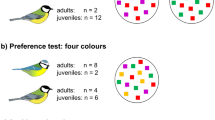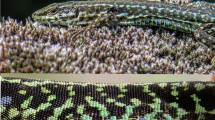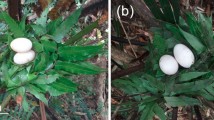Abstract
Research on the behavioural ecology of ultraviolet (UV-A, wavelengths of 320–400 nm, hereafter: UV) sensitivity in terrestrial vertebrates has mainly focused on sexual signalling and foraging in birds and reptiles, whereas the fact that some rodents are also sensitive to UV light has been somewhat ignored. Here, we present the results of two behavioural experiments, which tested whether rodents use UV cues in foraging. In the first experiment we asked whether the colour contrast in the UV waveband is used as a foraging cue. House mice were offered UV-reflecting and UV-absorbing artificial food items in two different illuminations where UV light was either present or absent. The food items were offered to two groups of mice, one group on a UV-reflecting and the other on a UV-absorbing background. The second experiment investigated more specifically whether UV cues are especially important in dawn and dusk when short wavelengths are high in the proportion of available light. House mice showed no preference between the food items regardless of illumination or background. Therefore, our results indicate that house mice do not use UV cues in foraging.





Similar content being viewed by others
References
Bennett ATD, Cuthill IC (1994) Ultraviolet vision in birds: what is its function? Vis Res 34:1471–1478
Brainard GC, Barker FM, Hoffman RJ, Stetson MH, Hanifin JP, Podolin PL, Rollag MD (1994) Ultraviolet regulation of neuroendocrine and circadian physiology in rodents. Vis Res 34:1521–1533
Brainard GC, Hanifin JP, Barker FM, Sanford B, Stetson MH (2001) Influence of near-ultraviolet radiation on reproductive and immunological development in juvenile male Siberian hamsters. J Exp Biol 204:2535–2541
Bowmaker JK, Hunt DM (2006) Evolution of vertebrate visual pigments. Curr Biol 16:484–489
Calderone JB, Jacobs GH (1995) Regional variations in the relative sensitivity to UV light in the mouse retina. Vis Neurosci 12:463–468
Calderone JB, Jacobs GH (1999) Cone receptor variations and their functional consequences in two species of hamster. Vis Neurosci 16:53–63
Chavez AD, Bozinovic F, Peichl L, Palacios AG (2003) Retinal spectral sensitivity, fur coloration, and urine reflectance in the genus Octodon (Rodentia): implications for visual ecology. Invest Ophth Vis Sci 44:2290–2296
Church SC, Bennett ATD, Cuthill IC, Partridge JC (1998) Ultraviolet cues affect the foraging behaviour of blue tits. Proc R Soc Lond B 265:1509–1514
Cuthill IC, Partridge JC, Bennett ATD, Church SC, Hart NS, Hunt S (2000) Ultraviolet vision in birds. Adv Study Anim Behav 29:159–214
Desjardins C, Maruniak JA, Bronson FH (1973) Social rank in house mice: differentiation revealed by ultraviolet visualization of urine marking patterns. Science 182:939–941
Endler JA (1993) The color of light in forests and its implications. Ecol Monogr 63:1–27
Honkavaara J, Siitari H, Viitala J (2004) Fruit colour preferences of redwings (Turdus iliacus): experiments with hand-raised juveniles and wild-caught adults. Ethology 110:445–457
Hunt S, Cuthill IC, Bennett ATD, Church SC, Partridge JC (2001) Is the ultraviolet waveband a special communication channel in avian mate choice? J Exp Biol 204:2499–2507
Hut RA, Scheper A, Daan S (2000) Can circadian system of a diurnal and a nocturnal rodent entrain to ultraviolet light? J Comp Physiol A 186:707–715
Huth HH, Burkhardt D (1972) Der spektrale Sehbereich eines Violetta Kolibris. Naturwissenschaften 59:650
Jacobs GH (1993) The distribution and nature of colour vision among the mammals. Biol Rev 68:413–471
Jacobs GH, Deegan JF II (1994) Sensitivity to ultraviolet light in the gerbil (Meriones unguiculatus): characteristics and mechanisms. Vis Res 34:1433–1441
Jacobs GH, Neitz J, Deegan II JF (1991) Retinal receptors in rodents maximally sensitive to ultraviolet light. Nature 353:655–656
Jacobs GH, Fenwick JA, Williams GA (2001) Cone-based vision of rats for ultraviolet and visible lights. J Exp Biol 204:2439–2446
Jacobs GH, Calderone JB, Fenwick JA (2003) Visual adaptations in a diurnal rodent, Octodon degus. J Comp Physiol A 189:347–361
Jacobs GH, Williams GA, Fenwick JA (2004) Influence of cone pigment coexpression on spectral sensitivity and color vision in the mouse. Vis Res 44:1615–1622
Kellie A, Dain SJ, Banks PB (2004) Ultraviolet properties of Australian mammal urine. J Comp Physiol A 190:429–435
Koivula M, Viitala J (1999) Rough-legged buzzards use vole scent marks to assess hunting areas. J Avian Biol 30:329–330
Koivula M, Korpimäki E (2001) Do scent marks increase predation risk of microtine rodents? Oikos 95:275–281
Koivula M, Korpimäki E, Viitala J 1997. Do Tengmalm’s owls see vole scent marks visible in ultraviolet light? Anim Behav 54:873–877
Koivula M, Koskela E, Viitala J (1999) Sex and age-specific differences in ultraviolet reflectance of scent marks of bank voles (Clethrionomys glareolus). J Comp Physiol A 185:561–564
Lyytinen A, Alatalo RV, Lindström L, Mappes J (2001) Can ultraviolet cues function as aposematic signals? Behav Ecol 12:65–70
Röhlich P, van Veen T, Szél Á (1994) Two different visual pigments in one retinal cone cell. Neuron 13:1159–1166
Shi Y, Yokoyama S (2003) Molecular analysis of the evolutionary significance of ultraviolet vision in vertebrates. Proc Natl Acad Sci USA 100:8308–8313. doi:10.1073/pnas.1532535100
Shi Y, Radlwimmer FB, Yokoyama S (2001) Molecular genetics and evolution of ultraviolet vision in vertebrates. Proc Natl Acad Sci USA 98:11731–11736. doi:10.1073/pnas.201257398
Siitari H, Honkavaara J, Viitala J (1999) Ultraviolet reflection of berries attracts foraging birds. A laboratory study with redwings (Turdus iliacus) and bilberries (Vaccinium myrtillus). Proc R Soc Lond B 266:2125–2129
Szél Á, Röhlich P, Caffé AR, Juliusson B, Aguirre G, Van Veen T (1992) Unique topographic separation of two spectral classes of cones in the mouse retina. J Comp Neurol 325:327–342
Tovée MJ (1995) Ultraviolet photoreceptors in the animal kingdom: their distribution and function. Trends Ecol Evol 10:455–460
Viitala J, Korpimäki E, Palokangas P, Koivula M (1995) Attraction of kestrels to vole scent marks visible in ultraviolet light. Nature 373:425–427
Wright AA (1972) The influence of ultraviolet radiation on the pidgeons’ color discrimination. J Exp Anal Behav 17:325–337
Yokoyama S, Yokoyama R (1996) Adaptive evolution of photoreceptors and visual pigments in vertebrates. Ann Rev Ecol Syst 27:543–567
Zampiga E, Gaibani G, Csermely D, Frey H, Hoi H (2006) Innate and learned aspects of vole urine UV-reflectance use in the hunting behaviour of the common kestrel Falco tinnunculus. J Avian Biol 37:318–322
Acknowledgements
We thank Asko and Ansa Kaikusalo for providing the house mice. This study was supported by the Academy of Finland under the Finnish Centre of Excellence Programme. Additional funding was supplied by the Jenny and Antti Wihuri Foundation (personal grants to JH). We also thank three anonymous referees for their constructive comments on the manuscript. Maxine Iversen kindly checked the language.
Author information
Authors and Affiliations
Corresponding author
About this article
Cite this article
Honkavaara, J., Åberg, H. & Viitala, J. Do house mice use UV cues when foraging?. J Ethol 26, 339–345 (2008). https://doi.org/10.1007/s10164-007-0068-6
Received:
Accepted:
Published:
Issue Date:
DOI: https://doi.org/10.1007/s10164-007-0068-6




